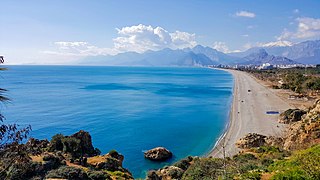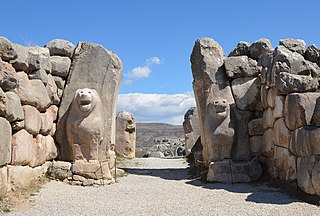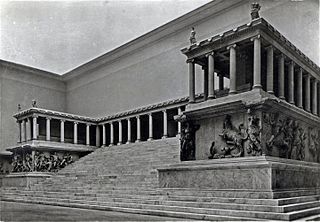Pergamon is an ancient Greek city in modern Turkey. Pergamon may also refer to:
Pergamon is an ancient Greek city in modern Turkey. Pergamon may also refer to:

Ephesus was a city in ancient Greece on the coast of Ionia, 3 kilometres (1.9 mi) southwest of present-day Selçuk in İzmir Province, Turkey. It was built in the 10th century BC on the site of Apasa, the former Arzawan capital, by Attic and Ionian Greek colonists. During the Classical Greek era, it was one of twelve cities that were members of the Ionian League. The city came under the control of the Roman Republic in 129 BC.

Pergamon or Pergamum, also referred to by its modern Greek form Pergamos (Πέργαμος), was a rich and powerful ancient Greek city in Mysia. It is located 26 kilometres (16 mi) from the modern coastline of the Aegean Sea on a promontory on the north side of the river Caicus and northwest of the modern city of Bergama, Turkey.

Konya is a major city in central Turkey, on the southwestern edge of the Central Anatolian Plateau, and is the capital of Konya Province. During antiquity and into Seljuk times it was known as Iconium. In 19th-century accounts of the city in English its name is usually spelt Konia or Koniah. In the late medieval period, Konya was the capital of the Seljuk Turks' Sultanate of Rum, from where they ruled over Anatolia.

The Museum Island is a museum complex on the northern part of the Spree Island in the historic heart of Berlin. It is one of the most visited sights of Germany's capital and one of the most important museum sites in Europe. Built from 1830 to 1930 by order of the Prussian Kings according to plans by five architects, Museum Island was designated a UNESCO World Heritage Site in 1999 because of its testimony to the architectural and cultural development of museums in the 19th and 20th centuries. It consists of the Altes Museum, the Neues Museum, the Alte Nationalgalerie, the Bode-Museum and the Pergamonmuseum. As Museum Island includes all of Spree Island north of the Unter den Linden, the Berliner Dom is also located here, near the Lustgarten. To the south, the reconstructed Berlin Palace houses the Humboldt Forum museum and opened in 2020. Since German reunification, the Museum Island has been rebuilt and extended according to a master plan. In 2019, a new visitor center and art gallery, the James Simon Gallery, was opened.

Antalya is the fifth-most populous city in Turkey as well as the capital of Antalya Province. It is seen as the "capital of tourism" in Turkey. Located on Anatolia's southwest coast bordered by the Taurus Mountains, Antalya is the largest Turkish city on the Mediterranean coast outside the Aegean region with over one million people in its metropolitan area.

Hattusa was the capital of the Hittite Empire in the late Bronze Age. Its ruins lie near modern Boğazkale, Turkey, within the great loop of the Kızılırmak River.

Bergama is a populous district, as well as the center city of the same district, in İzmir Province in western Turkey. By excluding İzmir's metropolitan area, it is one of the prominent districts of the province in terms of population and is largely urbanized at the rate of 53.6%. Bergama center is situated at a distance of 118 km (73 mi) to the north from the point of departure of the traditional center of İzmir and lies at a distance of 27 km (17 mi) inland from the nearest seacoast at the town of Dikili to its west. Bergama district area neighbors the areas of three districts of Balıkesir Province to its north, namely Ayvalık, Burhaniye and İvrindi, İzmir Province district of Kınık and Manisa Province district of Soma, Manisa to its east, while to the south it is bordered by the central provincial of Manisa and two other İzmir Province districts along the coast that are Aliağa and Dikili from its south towards its west. The district area's physical features are determined by the alluvial plain of Bakırçay River.

Magnesia or Magnesia on the Maeander was an ancient Greek city in Ionia, considerable in size, at an important location commercially and strategically in the triangle of Priene, Ephesus and Tralles. The city was named Magnesia, after the Magnetes from Thessaly who settled the area along with some Cretans. It was later called "on the Meander" to distinguish it from the nearby Lydian city Magnesia ad Sipylum. It was earlier the site of Leucophrys mentioned by several ancient writers.

The Pergamon Altar was a monumental construction built during the reign of the Ancient Greek King Eumenes II in the first half of the 2nd century BC on one of the terraces of the acropolis of Pergamon in Asia Minor.

Muğla is a city in southwestern Turkey. The city is the center of the District of Menteşe and Muğla Province, which stretches along Turkey's Aegean coast. Muğla's center is situated inland at an altitude of 660 m and lies at a distance of about 30 km (19 mi) from the nearest seacoast in the Gulf of Gökova to its south-west. Muğla (Menteşe) district area neighbors the district areas of Milas, Yatağan and Kavaklıdere to its north by north-west and those of Ula and Köyceğiz, all of whom are dependent districts. Muğla is the administrative capital of a province that incorporates internationally well-known and popular tourist resorts such as Bodrum, Marmaris, Datça, Dalyan, Fethiye, Ölüdeniz and also the smaller resort of Sarigerme.

Samʼal, also Yaʼdiya or Zincirli Höyük, is an archaeological site located in the Anti-Taurus Mountains of modern Turkey's Gaziantep Province. It was founded at least as far back as the Early Bronze Age and thrived between 3000 and 2000 BC, and on the highest part of the upper mound was found a walled citadel of the Middle Bronze Age. New excavations revealed a monumental complex in the Middle Bronze Age II, and another structure that was destroyed in the mid to late 17th century BC, maybe by Hititte king Hattusili I. It was thought to have been abandoned during the Hittite and Mitanni periods, but excavations in 2021 season showed evidence of occupation during the Late Bronze Age in Hittite times. It flourished again in the Iron Age, initially under Luwian-speaking Neo-Hittites, and by 920 B.C. had become a kingdom. In the 9th and 8th century BC it came under control of the Neo-Assyrian Empire and by the 7th century BC had become a directly ruled Assyrian province.

Assos was an ancient Greek city and today a historically important town located on the Aegean coast in the Ayvacık district of Çanakkale province, Turkey. It is on the southern side of Biga Peninsula. Assos sits on the coast of the Adramyttian Gulf (Turkish: Edremit Körfezi.and used to offer the only good harbour along the 80 kilometres of coast north of it which made it very important for shipping in the Troad.

Allianoi, is an ancient spa settlement, with remains dating predominantly from the Roman Empire period located near the city of Bergama in Turkey's İzmir Province. The site is at a distance of 18 kilometers to the northeast of Bergama, on the road to the neighboring town of İvrindi. Allianoi is directly inside the reservoir of the Yortanlı Dam, built by the Turkish State Hydraulic Works. After ongoing discussion in Turkey with regards to preserving Allianoi's ruins, the site was covered with sand and the dam was activated, resulting in Allianoi's complete inundation and destruction in February 2011.

Aigai, also Aigaiai, was an ancient Greek, later Roman, city and bishopric in Aeolis. Aegae is mentioned by both Herodotus and Strabo as being a member of the Aeolian dodecapolis. It was also an important sanctuary of Apollo. Aigai had its brightest period under the Attalid dynasty, which ruled from nearby Pergamon in the 3rd and 2nd century BC.
Pitane, near Çandarlı, Turkey, was an ancient Greek town of the ancient region of Aeolis, in Asia Minor. It was situated near the mouth of the river Evenus on the bay of Elaea. It was one of the eleven ancient Aeolian settlements, and possessed considerable commercial advantages in having two harbours. It was the birthplace of the academic philosopher Arcesilaus, and in the reign of Titus it suffered severely from an earthquake. The town is still mentioned by Hierocles. Pliny the Elder mentions in its vicinity a river Canaius, which is not noticed by any other writer; but it may possibly be the river Pitanes, spoken of by Ptolemy, and which seems to derive its name from the town of Pitane.

Akanthou is a village on the northern coast of Cyprus. It is under the de facto control of Northern Cyprus. As of 2011, it had a population of 1,459.

The "Red Basilica", also called variously the Red Hall and Red Courtyard, is a monumental ruined temple in the ancient city of Pergamon, now Bergama, in western Turkey. The temple was built during the Roman Empire, probably in the time of Hadrian and possibly on his orders. It is one of the largest Roman structures still surviving in the ancient Greek world. The temple is thought to have been used for the worship of Egyptian gods – specifically Isis and/or Serapis, and possibly also Osiris, Harpocrates and other lesser gods, who may have been worshipped in a pair of drum-shaped rotundas, both of which are virtually intact, alongside the main temple.

The Museum of Islamic Art is located in the Pergamon Museum and is part of the Staatliche Museen zu Berlin.

Bergama Museum is a museum in Bergama district of İzmir Province, Turkey.
It is located 9 km. northeast of Ödemiş/İzmir.(ref: Tmolos’ta saklı kutsal bir kent Dioshieron, Hüseyin Üreten, Journal of International Social Research, Vol 9, Issue 44: 562-578) Dios Hieron was a town of ancient Lydia, in the upper valley of the Cayster River. The city became part of the Roman Republic and the Roman province of Asia with the annexation of the Kingdom of Pergamon. It also bore the name Diospolis (Διόσπολις), and was cited by the sixth century Byzantine geographer Stephanus of Byzantium under that name. It was renamed to Christopolis or Christoupolis in the 7th century and was known as Pyrgium or Pyrgion (Πυργίον) from the 12th century on. Pyrgion fell to the Turks in 1307, and became the capital of the beylik of Aydin. The town minted coins in antiquity, often with the inscription "Διοσιερειτων".